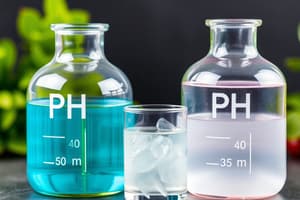Podcast
Questions and Answers
What is matter?
What is matter?
Everything that has mass and takes up space.
What is an acid?
What is an acid?
A chemical substance that neutralizes alkalis, dissolves some metals, and turns litmus red.
What is a base?
What is a base?
A chemical species that donates electrons or hydroxide ions or that accepts protons.
What is baking soda?
What is baking soda?
What is vinegar?
What is vinegar?
What does pH measure?
What does pH measure?
What is the pH scale?
What is the pH scale?
What is an acid-base indicator?
What is an acid-base indicator?
What does red litmus paper indicate?
What does red litmus paper indicate?
What does blue litmus paper indicate?
What does blue litmus paper indicate?
Flashcards are hidden until you start studying
Study Notes
Matter
- Defined as everything possessing mass and occupying space.
- Encompasses all physical substances in the universe.
Acid
- Chemical substance that neutralizes alkalis and can corrode metals.
- Characteristically sour; changes litmus paper to red.
- Plays a crucial role in processes such as food digestion.
Base
- Chemical species that donates electrons or hydroxide ions.
- Accepts protons; often appears slippery to the touch.
- Solids that counteract acids in chemical reactions.
Baking Soda
- Chemical formula: NaHCO₃; known as sodium bicarbonate.
- Appears as a crystalline white solid, often in powder form.
- Commonly used in cooking and baking, and has applications in oral hygiene.
Vinegar
- Primarily composed of acetic acid and water.
- Produced through the fermentation of ethanol by acetic acid bacteria.
- Widely used in cooking, pickling, and food preservation.
pH
- Measurement of acidity or basicity in aqueous solutions.
- pH value of less than 7 indicates acidity, while a value greater than 7 indicates basicity.
- Essential in food science to understand flavor profiles and preservation.
pH Scale
- Ranges from 0 to 14, determining the acidity of a substance.
- A pH of 7 represents neutrality; values below are acidic, above are basic.
- Used in various scientific applications, including food science.
Acid-Base Indicator
- A substance that shows the degrees of acidity or basicity through color changes.
- Useful in determining the pH level of solutions in experiments and cooking.
Red Litmus Paper
- Changes color to red when exposed to solutions with a pH below 4.5.
- Employed to test for acidic properties in various contexts.
Blue Litmus Paper
- Changes color to blue in the presence of solutions with a pH above 8.2.
- Used to identify basic properties of substances.
Studying That Suits You
Use AI to generate personalized quizzes and flashcards to suit your learning preferences.



